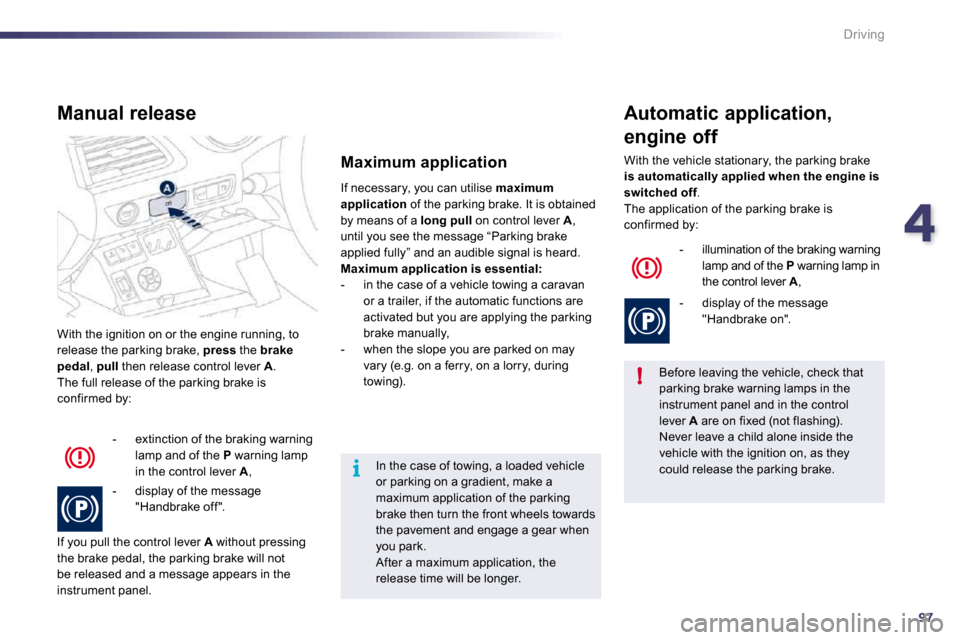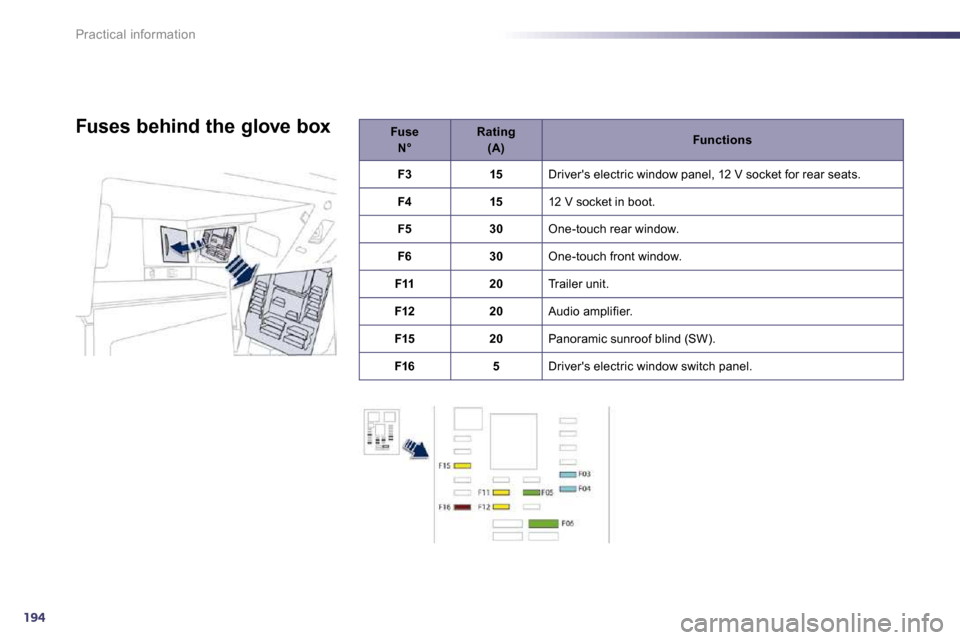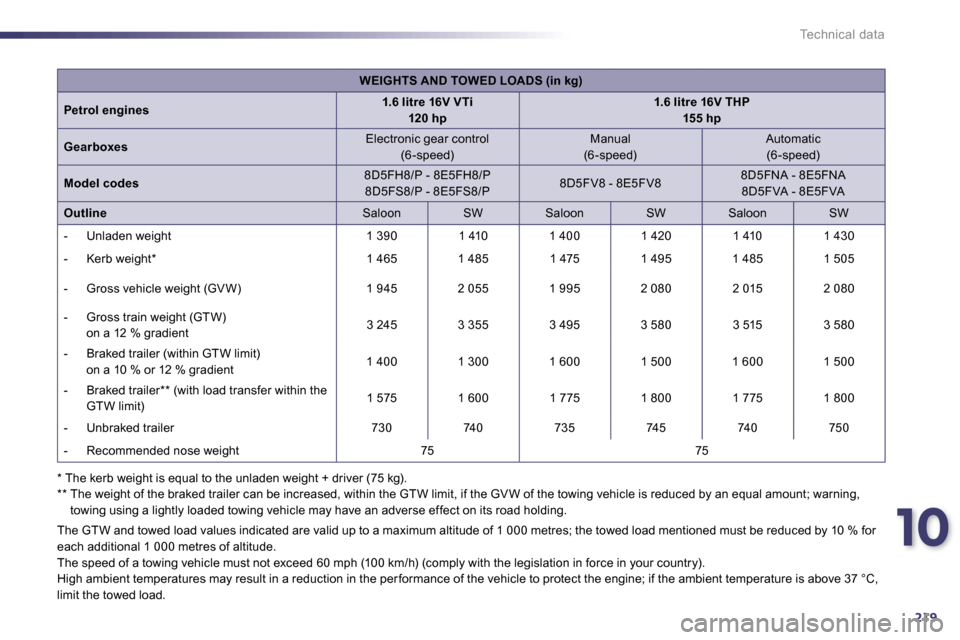2010.5 Peugeot 508 Dag trailer
[x] Cancel search: trailerPage 107 of 330

497
!
i
Driving
With the ignition on or the engine running, to release the parking brake, press the brake pedal , pull then release control lever A . The full release of the parking brake is confirmed by:
Manual release
- extinction of the braking warning lamp and of the P warning lamp in the control lever A ,
- display of the message "Handbrake off ".
If you pull the control lever A without pressing the brake pedal, the parking brake will not be released and a message appears in the instrument panel.
If necessary, you can utilise maximum application of the parking brake. It is obtained by means of a long pull on control lever A , until you see the message “Parking brake applied fully” and an audible signal is heard. Maximum application is essential: - in the case of a vehicle towing a caravan or a trailer, if the automatic functions are activated but you are applying the parking brake manually, - when the slope you are parked on may vary (e.g. on a ferry, on a lorry, during towing).
Maximum application
Before leaving the vehicle, check that parking brake warning lamps in the instrument panel and in the control lever A are on fixed (not flashing).
Never leave a child alone inside the vehicle with the ignition on, as they could release the parking brake.
Automatic application,
engine off
- illumination of the braking warning lamp and of the P warning lamp in the control lever A ,
- display of the message "Handbrake on".
With the vehicle stationary, the parking brake is automatically applied when the engine is switched off. The application of the parking brake is confirmed by:
In the case of towing, a loaded vehicle
or parking on a gradient, make a maximum application of the parking brake then turn the front wheels towards the pavement and engage a gear when you park. After a maximum application, the release time will be longer.
Page 138 of 330

126
i
i
Driving
In bad weather or in winter, ensure that the sensors are not covered with mud, ice or snow. When reverse gear is engaged, an audible signal (long beep) indicates that the sensors may be dir ty. When the vehicle is moving at a speed below 6 mph (10 km/h), cer tain sound sources (motorcycle, lorry, pneumatic
drill, etc.) may trigger the audible signals of the parking sensor system.
If an operating fault occurs, when reverse gear is engaged this warning lamp is displayed in the instrument panel and/or a message appears in the screen, accompanied by an audible signal (shor t beep). Contact a PEUGEOT dealer or a qualified workshop.
Operating fault
In addition to the rear parking sensors, the front parking sensors are triggered when an obstacle is detected in front and the speed of the vehicle is still below 6 mph (10 km/h). The sound emitted by the speaker (front or rear) indicates whether the obstacle is in front or behind. The front parking sensors are interrupted if the vehicle stops for more than three seconds in for ward gear, if no fur ther obstacles are detected or when the speed of the vehicle exceeds 6 mph (10 km/h).
Front parking sensors
The function will be deactivated automatically if a trailer is being towed or a bicycle carrier is fitted (vehicle fitted with a towbar or bicycle carrier recommended by PEUGEOT).
Deactivation/Activation of the front and rear parking sensors
The function is deactivated by pressing this button. The indicator lamp on the button comes on. Pressing this button again reactivates the function. The indicator lamp on the button switches off.
Page 209 of 330

194
Practical information
Fuse N°Rating (A)Functions
F315 Driver's electric window panel, 12 V socket for rear seats.
F415 12 V socket in boot.
F530 One-touch rear window.
F630 One-touch front window.
F1120 Trailer unit.
F1220 Audio amplifier.
F1520 Panoramic sunroof blind (SW).
F165 Driver's electric window switch panel.
Fuses behind the glove box
Page 218 of 330

202
i
Practical information Towing a trailer, a caravan, etc.
We recommend the use of genuine PEUGEOT towbars and their harnesses that have been tested and approved from the design stage of your vehicle, and that the fitting of the towbar is entrusted to a PEUGEOT dealer or a qualified workshop. If the trailer is not fitted by a PEUGEOT dealer, it is imperative that it is fitted using the vehicle's electrical pre-equipment, in accordance with the manufacturer's instructions.
Towbar suitable for the attachment of a trailer or caravan with additional lighting and signalling. Your vehicle is primarily designed for transpor ting people and luggage, but it may also be used for towing a trailer.
Driving with a trailer places greater demands on the towing vehicle and the driver must take par ticular care.
Blanking cover
When towing, you must remove the blanking cover in the front bumper if your vehicle has one. Contact a PEUGEOT dealer or a qualified workshop for this.
Page 219 of 330

202
i
Practical information Towing a trailer, a caravan, etc.
We recommend the use of genuine PEUGEOT towbars and their harnesses that have been tested and approved from the design stage of your vehicle, and that the fitting of the towbar is entrusted to a PEUGEOT dealer or a qualified workshop. If the trailer is not fitted by a PEUGEOT dealer, it is imperative that it is fitted using the vehicle's electrical pre-equipment, in accordance with the manufacturer's instructions.
Towbar suitable for the attachment of a trailer or caravan with additional lighting and signalling. Your vehicle is primarily designed for transpor ting people and luggage, but it may also be used for towing a trailer.
Driving with a trailer places greater demands on the towing vehicle and the driver must take par ticular care.
Blanking cover
When towing, you must remove the blanking cover in the front bumper if your vehicle has one. Contact a PEUGEOT dealer or a qualified workshop for this.
Page 220 of 330

8203
i
Practical information
Driving advice
Distribution of loads
� Distribute the load in the trailer so that the heaviest items are as close as possible to the axle and the nose weight approaches the maximum permitted without exceeding it. Air density decreases with altitude, thus reducing engine per formance. Above 1 000 metres, the maximum towed load must be reduced by 10 % for every 1 000 metres of altitude. Refer to the "Technical Data" section for details of the weights and towed loads which apply to your vehicle.
Side wind
� Take into account the increased sensitivity to side wind.
Cooling
Towing a trailer on a slope increases the temperature of the coolant. As the fan is electrically controlled, its cooling capacity is not dependent on the engine speed. � To lower the engine speed, reduce your speed. The maximum towed load on a long incline depends on the gradient and the ambient temperature. In all cases, keep a check on the coolant temperature.
� If the warning lamp and the STOP warning lamp come on, stop the vehicle and switch off the engine as soon as possible.
Braking
Towing a trailer increases the braking distance.
Tyres
� Check the tyre pressures of the towing vehicle and of the trailer, obser ving the recommended pressures.
Lighting
� Check the electrical lighting and signalling on the trailer.
The rear parking sensors will be deactivated automatically if a genuine PEUGEOT towbar is used.
Page 222 of 330

8205
Practical information
Accessories
A wide range of accessories and genuine par ts is offer ed by the PEUGEOT dealer network. These accessories and par ts have been tested and app roved for reliability and safety. They are all adapted to your vehicle and benefit from PEUGEOT's recommendation and warranty.
"Comfort":
cool box, smoker's kit, 230 V socket, torch...
"Transport solutions":
booster seats and child seats, boot tray, roof box, ski carrier, towbar-mounted bicycle carrier, towbars (swan-neck, quickly detachable ball, folding), harnesses, sliding floor, utility vehicle conversion kit, ... The trailer towbar and its harness must be
fitted by a PEUGEOT dealer.
"Style":
spoiler, front and rear mud flaps, aluminium gear lever knob, alloy wheels (16", 17", 18", 19"), body kit, door mirror shells, door air deflectors, ...
* To avoid any risk of jamming of the pedals: - ensure that the mat is positioned and secured correctly, - never fit one mat on top of another.
"Safety and security":
speed limiter/cruise control, anti-theft alarm, microwave unit, window etching, wheel security bolts, breathalyser, first aid kit, warning triangle, high visibility vest, stolen vehicle tracking system, winter equipment (17" wheels for snow chains), reversing camera, front and
rear parking sensors, boot spacers...
"Protection":
mats * , seat covers, vehicle covers, sun blinds, boot net, load protection net, dog guard, door and boot sill protectors, resin side rubbing strips...
Page 238 of 330

10
219
Technical data
* The kerb weight is equal to the unladen weight + driver (75 kg). ** The weight of the braked trailer can be increased, within the GTW limit, if the GV W of the towi ng vehicle is reduced by an equal amount; warning, towing using a lightly loaded towing vehicle may have an adverse effect on its road holding.
The GTW and towed load values indicated are valid u p to a maximum altitude of 1 000 metres; the towed load mentioned must be reduced by 10 % for each additional 1 000 metres of altitude. The speed of a towing vehicle must not exceed 60 m ph (100 km/h) (comply with the legislation in force in your country). High ambient temperatures may result in a reduction in the per formance of the vehicle to protect the engine; if the ambient temperature is above 37 °C,
limit the towed load.
WEIGHTS AND TOWED LOADS (in kg)
Petrol engines1.6 litre 16V VTi120 hp1.6 litre 16V THP155 hp
Gearboxes Electronic gear control (6 -speed) Manual (6 -speed) Automatic (6 -speed)
Model codes 8D5FH8/P - 8E5FH8/P8D5FS8/P - 8E5FS8/P 8D5FV8 - 8E5FV8 8D5FNA - 8E5FNA8D5FVA - 8E5FVA
Outline Saloon SW Saloon SW Saloon SW
- Unladen weight 1 390 1 410 1 400 1 420 1 410 1 430
- Kerb weight * 1 465 1 485 1 475 1 495 1 485 1 505
- Gross vehicle weight (GV W) 1 945 2 055 1 995 2 080 2 015 2 080
- Gross train weight (GTW) on a 12 % gradient 3 245 3 355 3 495 3 580 3 515 3 580
- Braked trailer (within GTW limit) on a 10 % or 12 % gradient 1 400 1 300 1 600 1 500 1 600 1 500
- Braked trailer ** (with load transfer within the GTW limit) 1 575 1 600 1 775 1 800 1 775 1 800
- Unbraked trailer 730 740 735 745 740 750
- Recommended nose weight 75 75